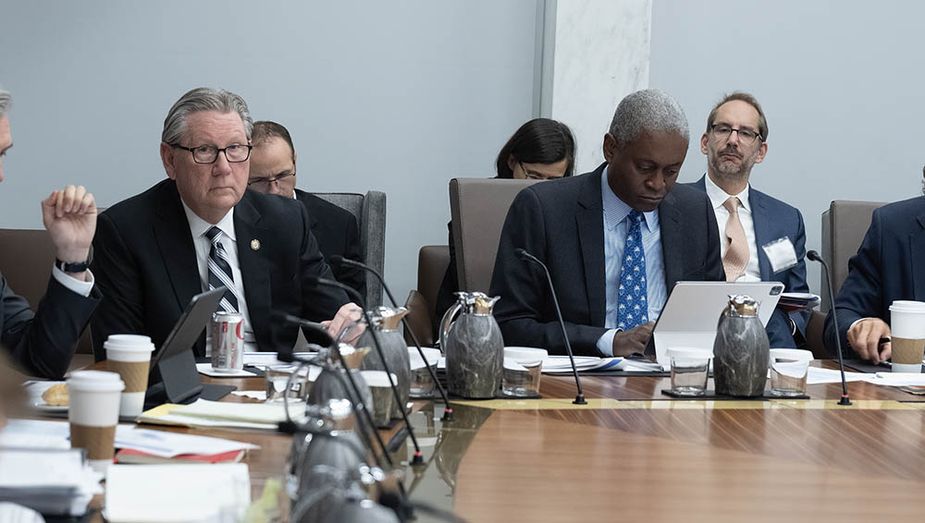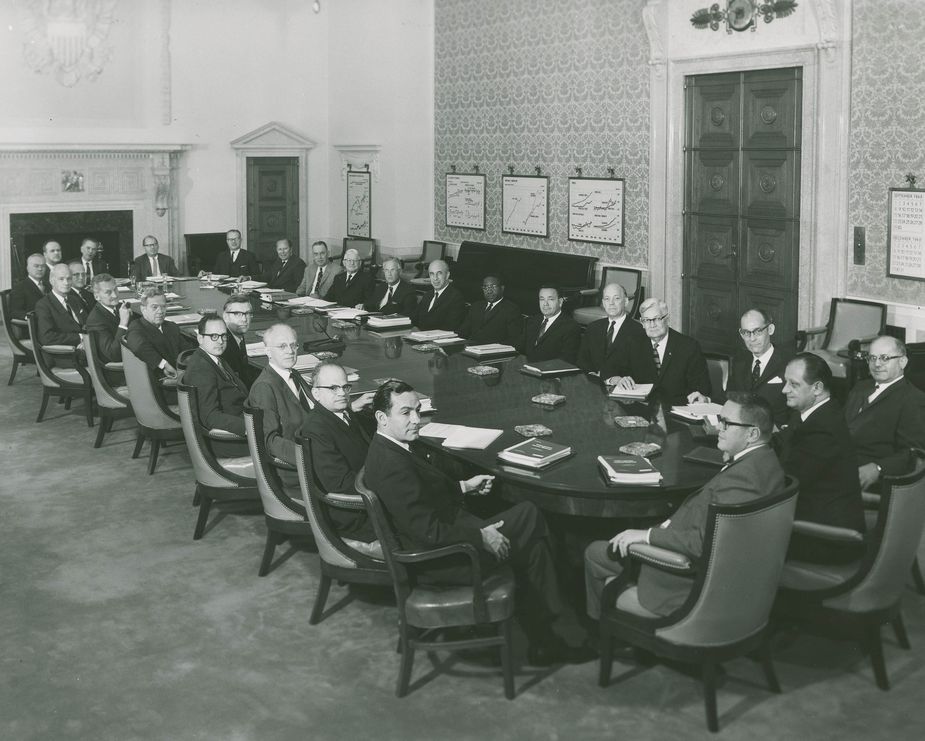
Kansas City Fed President and CEO Jeff Schmid, shown here at a 2023 Federal Open Market Committee meeting, became a policy voter in 2025. Photo courtesy of the Board of Governors
The Federal Reserve’s Federal Open Market Committee (FOMC) is responsible for the central bank’s open market operations. Its decisions about interest rates are closely watched by the public, media and market participants because they eventually affect both short- and long-term rates as well as the availability of money and credit.
Congress gave responsibility for the nation’s monetary policy to the Federal Reserve. The committee that guides those policy decisions has changed numerous times throughout the Fed’s history before arriving at the modern-day structure with 12 voting positions on the FOMC comprising the seven members of the Board of Governors and five of the 12 Federal Reserve Bank presidents.
This year, Kansas City Fed President Jeff Schmid is a policy voter for the first time since he was appointed Bank president in 2023. The Kansas City Fed president holds a voting seat one out of every three years on an annually rotating schedule that is shared with the Minneapolis and San Francisco Feds. Eleven of the Reserve Bank presidents vote on similarly rotating schedules, while the president of the Federal Reserve Bank of New York, who serves as FOMC vice chair, is always a policy voter.
Regardless of voting status, all Reserve Bank presidents participate in policy deliberations and share their views of the economic outlook during FOMC meetings, ensuring that their regions have a voice in policy actions.
This was not always the case. For example, until the mid-1950s participation in policy deliberations was most often handled by a smaller subgroup of Fed officials. As Allan Meltzer explained in Volume 2 of his Fed history, as recently as the 1950s many of the Reserve Bank presidents did not hold strong policy views. Given that attending a meeting would have required a train ride, it may be understandable why presidents of Reserve Banks in the Midwest and West might have preferred to stay home.
Policy committee evolution
The world today is far different from the one at the time of the Fed’s creation in innumerable ways.
In the Fed’s earliest days, the Reserve Banks conducted their own market operations independently. With many banks soon deciding to route their activities through New York as a matter of practicality, the New York Fed began trying to coordinate policy under the direction of New York Fed President Benjamin Strong Jr. Beginning in 1922, Strong chaired the Committee on the Centralized Execution of Purchases and Sales of Government Securities, which included Reserve Bank presidents from Boston, Chicago, Philadelphia and Cleveland. Participation by the individual Reserve Banks in the committee’s actions was voluntary.
The Board of Governors, in its oversight role, formally abolished Strong’s committee in 1923 and created the Open Market Investment Committee with the same members and same rules as far as the voluntary participation by the other Reserve Banks, but the new committee operated under the “general supervision” of the Board. Soon, the Banks that did not have permanent seats at the committee table voiced their frustrations, leading the Board to once again remake the committee, establishing another iteration known as the Open Market Policy Conference in January 1930. This committee involved all Reserve Bank presidents in deliberations with the Fed’s governors, which generally determined a broad direction of policy meeting far less frequently, perhaps as little as four times per year. The actual implementation, however, was handled by a smaller executive committee which met every few weeks and was composed of the same five Banks that had been on Strong’s initial committee in 1922: New York, Boston, Chicago, Philadelphia and Cleveland.
Participation remained voluntary, which became problematic as Banks soon began to opt out of some open market transactions. In some cases, although it may be difficult to believe, the actions that the Banks took as far as participating did not align with the views expressed by their presidents. The lack of coordination during this period is frequently noted in criticisms regarding the Fed’s behavior and decision making during the Great Depression.
The Banking Act of 1933, then, sought to address the confusion, creating the first iteration of today’s Federal Open Market Committee (FOMC) with all 12 Reserve Banks as members. The Act also essentially forced each of the Reserve Banks to participate in all open market operations, only allowing them to opt out with 30 days prior notice. The new structure also gave the Board a direct role in policy beyond contributing to deliberations, giving it veto authority over FOMC decisions. Policy, however, still remained primarily the purview of the Reserve Banks. The Fed governors, for example, could not initiate policy. This version of the FOMC met for the first time on July 20, 1933, and, among its first acts, it once again created an executive committee made up of the same group of Banks that Strong had organized more than 10 years earlier.
The FOMC structure was revised through the Banking Act of 1935, establishing the parameters for the structure that exists today. Under this system, the FOMC included the seven governors and five presidents selected by Reserve Bank directors who chose one representative from each of the following groups of Banks: Boston and New York; Philadelphia and Cleveland; Chicago and St. Louis; Richmond, Atlanta and Dallas; and Minneapolis, Kansas City and San Francisco.
Although the legislation did not call for a rotation of FOMC participation among the participants, it functioned that way within each group. There was, however, an exception in the New York/Boston group where Boston always deferred to New York, giving New York a de facto permanent position as an FOMC voter. This deference by the Boston Fed recognized New York’s close connection to the markets and the apparent lack of interest and experience in market operations among some of the other Reserve Bank presidents during this period.
That status was formalized in July 1942 when Congress changed the FOMC groupings, making New York’s status as a permanent voter official while placing Boston into a group with Richmond and Philadelphia. The action also moved Cleveland and Chicago into their own group, and put St. Louis with Atlanta and Dallas. The Minneapolis/Kansas City/San Francisco grouping did not change.
Once again, the FOMC created the executive committee structure, although with slight modification. This version of the executive committee was made up of three governors, including the Fed chairman, and two Bank presidents. Although the two Reserve Bank seats were not assigned to specific Banks, in practice one of the spots was filled by the New York Fed while the other seat was primarily held by Philadelphia (eight times) or Richmond (seven times). Similar to its previous incarnations, the executive committee was responsible for directing the executions of transactions “in accordance with the open-market policies adopted” by the FOMC.

The Federal Open Market Committee met on Oct. 9, 1968, in Washington, D.C., with Chairman William McChesney Martin Jr. and Kansas City Fed President George H. Clay in attendance. From Federal Reserve archives
A new structure
In 1955, under the leadership of Fed Chairman William McChesney Martin Jr., the executive committee was abolished, with its duties handled by the full FOMC.
In explaining his desire to do away with the executive committee, Martin said he believed that the FOMC was the “heart and core” of the Federal Reserve and that the full committee should have responsibility for decisions related to open market policy and operations. In response to a question from Kansas City Fed President Gavin Leedy, Martin clarified that the non-voting Reserve Bank presidents were welcome to attend the FOMC meetings, which would occur about every three weeks.
Martin said his proposal was “intended to give everybody more participation…than they might have had in the past in all the decisions of the Open Market Committee.” He told the Committee that he felt there had been times when more input from the presidents and the governors would have been helpful. He was also concerned about “islands” developing within the System—a point sometimes made by members of Congress and others, especially about the New York Fed.
Soon after, Martin began to institute the meeting “go around” soliciting input from all of the presidents including the non-voters. As Meltzer notes, initially, this change did not make much of a substantive difference, but it did change the dynamic over time. Today, it is the standard process during the FOMC’s eight scheduled meetings that it holds every year. Meanwhile, the public comments made by Reserve Bank presidents during speeches and other events are closely monitored by the financial press for insight on the economic outlook and signs about where interest rates may be headed.
The views expressed are those of the authors and do not necessarily reflect the positions of the Federal Reserve Bank of Kansas City or the Federal Reserve System.
